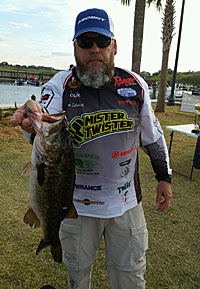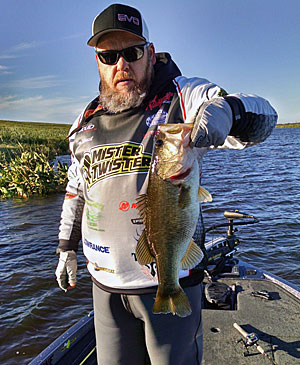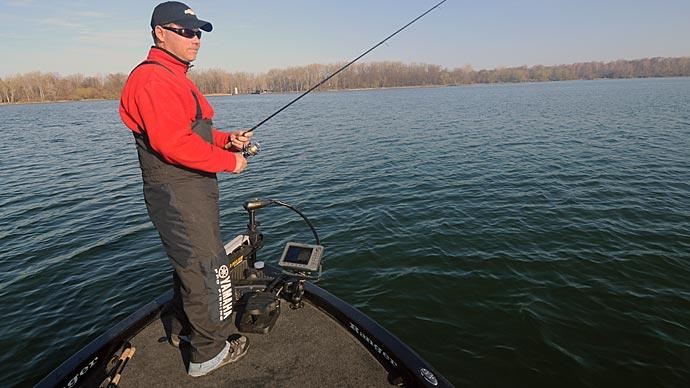
Derek Herring and Tim Zdrazil are full-fledged bass anglers. And like many others, they log onto social media to discuss their latest fishing adventures when they can’t get on the water. It’s there — Twitter specifically — that they first crossed paths. Stories and tips were exchanged, and eventually, an outing was scheduled. Zdrazil offered to host Herring for a day on Florida’s famed Lake Okeechobee.
When that time came, the two shoved off for a day of fishing. At their second stop, bass were schooling over submerged aquatic vegetation. Herring said they each caught one on a spinnerbait within the first few casts, but that bite quickly cooled. So he switched to a swim jig, believing its smaller profile would prove more enticing to the bass.
Herring fired his swim jig into the school of bass. One inhaled it — and spit it out — almost immediately. “They wouldn’t commit to the bait,” Zdrazil said. But Herring had a trick to try. About a month earlier, he received a new type of fish attractant. He had some success using it on his home lakes but was unsure whether to chalk up those bass to the attractant or his history on local waters. He decided to give the attractant another try. It wasn’t going to hurt.
Herring rubbed his swim jig with the attractant and made a cast. A 5-pounder choked it, and the catching continued. Zdrazil said Herring outfished four or five bass to each one he caught from the school. They were throwing identical swim jigs with identical trailers, but the bass wouldn’t touch Zdrazil’s offering. “The only thing [different Herring] did was put scent on his lure,” Zdrazil said. Being a proper guest, Herring offered to share. “Tim put it on, and within a cast or two, he had his 5-pounder,” he said.
Fish attractants — also called scents — have been around in one form or another for decades. There was a spike in their popularity in the early to mid-1980s, led by Fish Formula, Berkley Strike, and BANG, packaged in an aerosol can. Berkley introduced PowerBait soon after. Its Gulp! lures, which marinate in a liquid attractant, were next. Both incorporated scent into soft-plastic lures. They changed the game and convinced many anglers that they no longer needed to apply liquid scents to their baits, though some remained dedicated to the practice.
But that wasn’t the only reason liquid scents disappeared from many anglers’ tackle boxes. Fishing tactics were changing. Flipping and pitching, whose baits are perfect delivery systems for scents, were waning, and cranking — shallow with square bills and deep with long-billed divers — became more popular as the primary tournament trails fished farther into summer.
But just as bass cycle through, their seasonal patterns, lures, and techniques that were once popular disappear and then reappear. Attractants are no exception and are undergoing a resurgence. “Any angler is looking for an edge that will maximize opportunities,” said Chad Morningstar, managing director of Ontario, Canada-based Mayhem Bait Co. Inc., which makes Liquid Mayhem fish attractants.
Anglers who have experienced bass fishing success while using lures doused in attractant know they work. And science is on their side. Bass can detect 1/200th of a drop of attractant in 100 gallons of water, according to Liquid Mayhem’s website, and they can smell a baitfish swimming up to 25 feet away. Morningstar knows that’s solid proof that attractants work. “There are days when fishing a tube with scent is out fishing a tube without scent three to one or four to one,” he said. “I won’t fish a bait without it because I feel I put myself at a disadvantage without it.”

Herring and Zdrazil are firm believers in fish attractants. “Now I know it can make a difference,” Zdrazil said after recounting the Lake Okeechobee trip. “I use it on every single bait and every single presentation. I even put it on a buzzbait.” But the two anglers didn’t always think that way.
Zdrazil lives in Crawfordville, Fla., and fishes tournaments, including BFLs and the American Bass Anglers Ram Truck Open Series. Those take him across the Sunshine State to lakes filled with aquatic vegetation. He does a lot of flipping. “I was skeptical that [attractants] helped — with one exception,” he said. He said some spray scents have an oil base, and slathering it on flipping baits helps them slide into thick vegetation. “I was under the impression that there were zero circumstances when it would help me catch better.”
Herring lives in Houston, spending most of his fishing time on the nearby tidal bays, competing in tournaments organized by Bayou Bassin’ League. “I’ve been fishing for 50 years,” he said. “Any new gimmick that has come along I tried at least once.” That includes fishing scents — store-bought and homemade. “I used to buy crushed garlic and put it in with my worms,” he said.
He recognized the benefits of early attractants, such as masking smells that repel bass but was discouraged from using them because they quickly washed from his lures. “I used it before, but it was a real pain to spray or dip it on every five casts,” Herring said. He figured repeatedly adding attractant cost him 20 or 30 minutes of fishing time each trip.
There are two primary ways to manufacture fishing scents, Morningstar said. The first involves a laboratory where chemists recreate compounds found in bass prey. Morningstar’s company takes the other approach. Its Liquid Mayhem attractants start with ground crawfish, minnows, or shad. That organic material is cured, and amino acids and bite stimulants are added. Then the concoction is blended with a gel compound and placed in tubes for anglers to use. These newer gel-based scents cling longer to lures, such as Smelly Jelly and Liquid Mayhem. That means fewer applications, which Herring said causes him to miss maybe five or ten casts each fishing day. “I measured spray scents in minutes,” he said. “Now I measure Liquid Mayhem in casts.”

Both anglers use attractants less as their lures move more. Herring will add scent to his spinnerbait trailer if bass are bumping it, but he won’t bother with an attractant on any lure sporting treble hooks such as crankbaits or topwaters. He said there are enough hook points on those to snag a fish, even if it only slaps at the lure.
Zdrazil also believes attractants are more effective with slow presentations such as jigs, worms, and drop shots. When flipping, he coats his lure from the weight to the tips of its trailer. Herring puts some on the end of his jig trailers and rubs it in. “A dab will do you,” he said. “The more you put on, the stronger the [scent] trail your lure will leave.”
Herring said you can see Liquid Mayhem's trail in the water. He has watched bass cross that trail, 5 to 6 feet behind the lure. Once they get a whiff, he said, they turn and follow it toward his offering. He’s messed around with shakey heads or drop shots in clear water, watching how bass react to them. Their response changes when he adds scent to them. “They hold on and won’t let go,” he said. “I fish a swim jig fast. I want them to hold onto it, so I can set the hook when they grab it.”
While longevity is an improvement, today’s attractants still share benefits with their predecessors. Acting as a masking agent is probably the most significant similarity. Zdrazil is extremely vigilant about not tainting his lures with foreign scents that can repel bass. He said sunblock is one of the worst, so instead of slathering some on, he covers himself with clothing. “I’m terrified of getting [sunblock] on a bait,” he said. But it’s not the only offender. Herring said: “When that bass does grab the bait, you don’t have to worry about the scent of gas, sunblock, or food — things that don’t taste like what they eat — coming from your lures.”
Once you’ve decided to take advantage of attractants, you need to choose one to use. There are many brands and flavors available. Zdrazil’s favorite scent is Liquid Mayhem’s garlic minnow. It’s the one Herring used on that fateful day on Lake Okeechobee. He uses it whenever he needs a whiff of confidence, but he tries to match the scent to the prey his lure is imitating. “I can’t see any argument where making the bait smell more like the real thing will hurt it,” he said. If he’s crawling his jig around rocks like a crawfish, he’ll use a crawfish flavor. Herring agrees that it’s best to match scents to lures. He reaches for a shad-based scent when throwing a swim jig or soft-plastic swim bait, which imitates minnows and bream.
Like all lures and techniques, scents are not a silver bullet for fishing success. You still have to be around the bass. “Then you’ll see the difference,” Zdrazil said. “It’s not magic. It’s not going to make them jump in the boat.” Instead, attractants are one component in a multifaceted approach that ends in catching more bass. “If they are close to the bait, and it’s not quite right,” he said, “it might be the thing that makes them commit.”
BassResource may receive a portion of revenues if you make a purchase using a link above.




